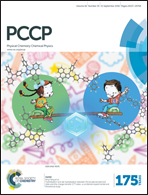Unraveling multiple binding modes of acridine orange to DNA using a multispectroscopic approach
Abstract
The interaction of acridine orange (AOH+) with calf thymus DNA (ct-DNA) under different dye–DNA conditions has been investigated in detail using multispectroscopic techniques, unraveling a number of hitherto unexplored intricacies of dye–DNA binding. The observed results intriguingly show contrasting binding features when low (2.4 μM) and significantly high (23 μM) dye concentrations are used. It is conclusively inferred from absorption, steady-state fluorescence, circular dichroism, fluorescence decay and anisotropy decay studies that at low [DNA] to [dye] ratio, especially with higher dye concentration, dimeric AOH+ predominantly binds externally to DNA surfaces through electrostatic interactions. At sufficiently high [DNA] to [dye] ratios, however, the interaction intriguingly changes to monomeric AOH+ bound to DNA, predominantly in the intercalative mode between DNA base pairs, with partly an electrostatic binding on DNA surfaces. With very low initial dye concentration, monomeric (AOH+) mostly binds to DNA through intercalative and electrostatic modes for most DNA to dye ratios. The present study demonstrates a systematic correlation of the striking changes in the photophysical properties of the dye upon multimode binding with DNA. The observed results are of great significance in understanding the fundamental insights of dye/drug binding to DNA hosts, of use in the design of effective therapeutic agents.


 Please wait while we load your content...
Please wait while we load your content...